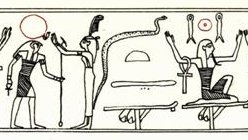5. In the eye of the old one is the origin of new life (light, movement). When we go to sleep we close our eyes. Fishes do not: "The principal word for 'fish' in most Dravidian languages is min, which has an ancient homophone meaning 'star', both probably derivatives of the root min 'to glitter'." "Fish are actually unable to close their eyes, and the fact that 'when the fish sleeps it does not close its eyes' was noticed by ancient Indians. The dot-in-a-circle similar to that occuring among the trefoils of the Harappan priest-king's robe is identical with the eye of the many small hare- and fish-shaped amulets discovered on the lower levels of Harappa." (Asko Parpola, The Sky Garment.) The stars which continue to shine in the night must therefore be the eyes of fishes. A dot-in-a-circle was used also by the ancient Egyptians:
The growing Sun - depicted as if uplifted on the head of Horus (the falcon god at the eastern horizon) - is here illustrated as an oval with a single rim from which emerges the head of a serpent. In the center of the day there is a T-formed construction at bottom (like the bird-snare of Orion). Above is a horizontal flat 'pancake' (henua) which could represent earth, and it has 3 dots below:
Above 'earth' is a semicircle which could represent the high sky of midsummer, and at this point a fully grown serpent (Ra) moves ahead and upwards. I guess he moves into the center of the oval and becomes the 'pupil of the eye'. It becomes the germ of next generation and will later return as a little snake born again from the Moon oval above the head of Horus. The 2 'fishes' rising at the back and in front of the 'eye with a pupil' presumably refer to the 2 faces of Moon. Each of them has an open 'eye' (formed as a hole). Beyond midsummer Moon will rule, which also is shown by the 2 goddesses sitting on the T-formed 'bird snares'. There are 3 such T-formed contraptions, and number 3 suggests 'without limit', 'forever', etc. (Wilkinson explains these goddesses as signs of 'eternity'). I.e., by 'impregnating' Moon by his 'rays' Sun will return in an eternal cycle. The serpent is his male member, and its head will be buried at 'noon' when Sun is fully grown, because that is the way to secure a continuation of life. The dot in the 'eye of Sun', the pupil, is Sun himself, carried inside Moon during the night in order to reemerge again next day. The double-rimmed Sun disc could basically be a picture of Sun inside Moon, and we can be fairly sure the same idea was in the minds of the rongorongo writers. The vai glyph type represents Moon if it has a single rim, when Sun is asleep:
The dormant stage of Sun during the night corresponds to the season of takaure, when the 'snake' (ure) is curled up (takai) inside Moon (written with double o):
|
||||||||||||||


